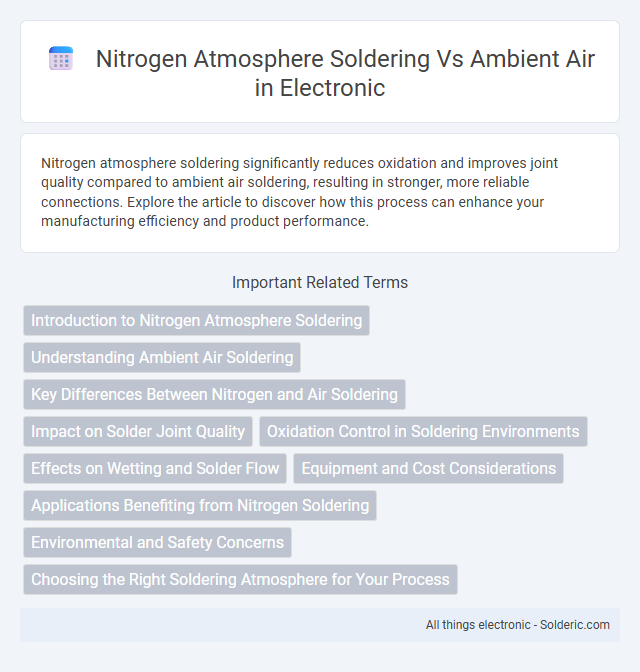Nitrogen atmosphere soldering significantly reduces oxidation and improves joint quality compared to ambient air soldering, resulting in stronger, more reliable connections. Explore the article to discover how this process can enhance your manufacturing efficiency and product performance.
Comparison Table
| Aspect | Nitrogen Atmosphere Soldering | Ambient Air Soldering |
|---|---|---|
| Oxidation | Minimized due to nitrogen, reduces oxidation on solder joints | Higher oxidation, requires more flux or cleaning |
| Solder Joint Quality | Cleaner, stronger, and more reliable joints | Less consistent, prone to defects from oxidation |
| Flux Usage | Lower flux requirement | Higher flux quantity needed to prevent oxidation |
| Process Control | Better atmosphere control, consistent results | Less control, variable environmental influence |
| Equipment Cost | Higher initial investment due to nitrogen supply system | Lower equipment and operating costs |
| Environmental Impact | Reduced solder fumes and flux residues | Higher emissions, more residues generated |
| Throughput | Potentially higher due to fewer defects and reworks | Lower due to increased defects and cleaning |
Introduction to Nitrogen Atmosphere Soldering
Nitrogen atmosphere soldering enhances solder joint quality by reducing oxidation and minimizing voids during the reflow process, leading to improved reliability and electrical performance. Using nitrogen instead of ambient air creates an inert environment that protects components and solder surfaces from oxidation, resulting in cleaner and stronger solder joints. Your manufacturing process benefits from higher yields and lower rework rates when incorporating nitrogen atmosphere soldering techniques.
Understanding Ambient Air Soldering
Ambient air soldering involves using the natural environment without controlling the gas composition, exposing solder joints to oxygen and moisture that can cause oxidation and reduce joint quality. Nitrogen atmosphere soldering minimizes oxidation by displacing oxygen with nitrogen gas, resulting in cleaner, stronger solder joints and less need for flux. Your choice affects soldering reliability, especially for sensitive components and high-performance electronics.
Key Differences Between Nitrogen and Air Soldering
Nitrogen atmosphere soldering significantly reduces oxidation during the soldering process, resulting in cleaner joints and improved wetting compared to ambient air soldering. The inert nature of nitrogen minimizes defects such as solder balling and dross formation, enhancing overall solder quality and reliability. Your manufacturing yield benefits from the controlled environment, which supports higher thermal efficiency and reduces post-soldering cleaning requirements.
Impact on Solder Joint Quality
Nitrogen atmosphere soldering significantly improves solder joint quality by reducing oxidation during the heating process, resulting in cleaner, stronger, and more reliable joints with enhanced wetting properties. In contrast, ambient air soldering exposes joints to oxygen, increasing the risk of oxidation, which can cause voids, weak bonds, and potential joint failure. Optimizing your soldering environment with nitrogen ensures consistent solder integrity and long-term performance in electronic assemblies.
Oxidation Control in Soldering Environments
Nitrogen atmosphere soldering significantly reduces oxidation by displacing oxygen and moisture, creating an inert environment that prevents solder joint defects. Ambient air soldering exposes components to oxygen, increasing oxidation risks and potentially compromising joint reliability and appearance. Using nitrogen atmosphere ensures your soldering process achieves higher-quality, oxidation-free joints, enhancing overall PCB performance.
Effects on Wetting and Solder Flow
Nitrogen atmosphere soldering significantly improves wetting by reducing oxidation on the solder and component surfaces, resulting in enhanced solder flow and stronger joint formation. In contrast, ambient air soldering exposes surfaces to oxygen, creating oxides that hinder solder wetting and impede uniform flow. Enhanced wetting and better solder flow in nitrogen environments lead to higher reliability and fewer defects in electronic assemblies.
Equipment and Cost Considerations
Nitrogen atmosphere soldering requires specialized equipment such as nitrogen generators or gas cylinders, resulting in higher initial investment compared to ambient air soldering systems. The cost of maintaining a nitrogen supply and ensuring proper gas flow control increases operational expenses, but it reduces oxidation and improves solder joint quality. You should weigh these equipment and cost factors against the potential yield improvements when deciding between nitrogen atmosphere and ambient air soldering.
Applications Benefiting from Nitrogen Soldering
Nitrogen atmosphere soldering significantly improves solder joint quality by reducing oxidation and enhancing wetting, making it ideal for high-reliability electronics manufacturing such as aerospace, automotive, and medical devices. Applications involving fine-pitch components, lead-free solder alloys, and complex multilayer PCBs benefit from nitrogen soldering due to its ability to produce cleaner, stronger joints with fewer defects. Compared to ambient air soldering, nitrogen atmosphere soldering reduces the need for post-solder cleaning and decreases the risk of soldering defects like bridging and tombstoning, increasing overall yield and product performance.
Environmental and Safety Concerns
Nitrogen atmosphere soldering significantly reduces oxidation and the release of harmful flux fumes compared to ambient air soldering, leading to a cleaner working environment and improved operator safety. The inert nitrogen environment minimizes the formation of nitrogen oxides and other volatile organic compounds (VOCs), contributing to lower air pollution and compliance with environmental regulations. Reduced exposure to hazardous fumes lessens respiratory risks for workers, making nitrogen atmosphere soldering a safer alternative in electronics manufacturing.
Choosing the Right Soldering Atmosphere for Your Process
Choosing the right soldering atmosphere significantly impacts the quality and reliability of solder joints, with nitrogen atmosphere soldering offering superior oxidation prevention compared to ambient air. Inert nitrogen gas minimizes oxidation and reduces the need for flux, resulting in cleaner, stronger joints and fewer defects such as voids or solder balling. While ambient air soldering is cost-effective, nitrogen atmosphere provides enhanced process control and consistency, crucial for high-reliability electronics manufacturing.
Nitrogen atmosphere soldering vs ambient air Infographic

 solderic.com
solderic.com